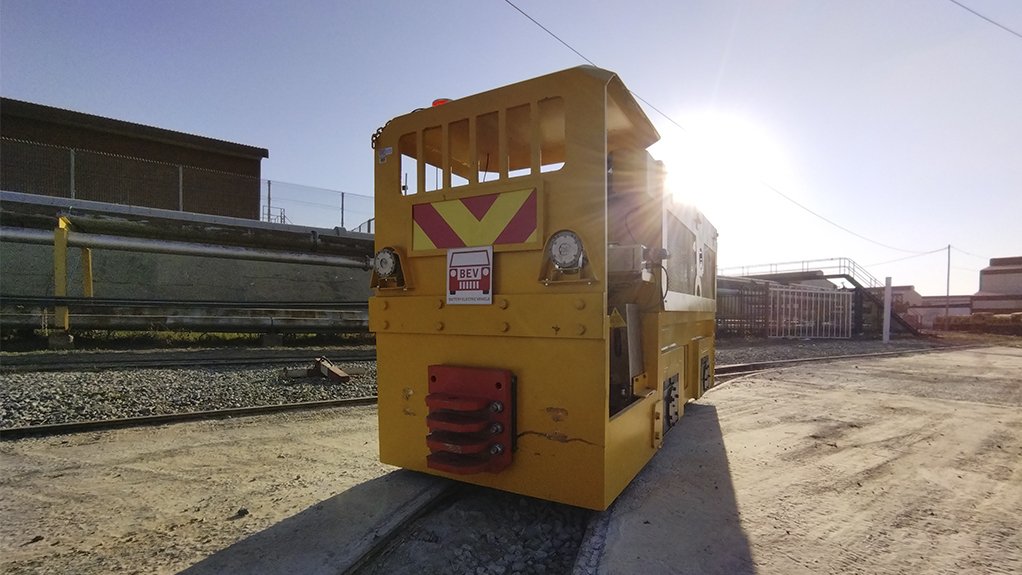Following successful surface trials, mining major Sibanye-Stillwater has approved the testing of a 5 t diesel, hydraulic underground mining locomotive converted into an environment-friendly battery powered electric version.
The locomotive was adapted using Gauteng-based underground railway control systems manufacturer Battery Electric’s diesel machine conversion technology, which took two years to develop.
Battery Electric design engineer Marnus Marais explains that the efficiency, control and safety of the existing machine was significantly improved while the production of carbon emissions has been eliminated, complementing the global initiative to achieve net zero emissions by 2050.
The conversion of a fossil-fuelled vehicle to a battery electric vehicle requires moderate capital outlay and is accompanied by various cost savings. These include the reduced cost of ventilation, diesel and oil spillages, operational energy, labour and maintenance, as well as costs associated with diesel storage, transport, logistics and labour.
When replacing the diesel engine with an electric motor, the existing chassis is retained. While the air and nose pollution associated with haulages is reduced, so is heat generation, energy wastage and the spillage and risk associated with diesel transportation.
The lithium battery, which has a minimum operational lifespan of five years, is maintenance free, as is the drivetrain, bar a yearly oil inspection. No special infrastructure is required for charging, with a fast-charging capability available.
The conversion technology currently comprises 87% locally and 13% internationally sourced components.
“The international component sourced by Battery Electric offers advanced, cutting-edge technology and an extremely compact design, addressing space constraints. Currently, there is no local equivalent,” says Marais.
The Battery Electric diesel machine conversion technology includes a three-phase inverter, a radiator, a cooling pump and a reduction gearbox, which allows the system to produce maximum torque and lets the electric motor operate in its most efficient range. This is in addition to a lithium battery and a sprocket adaptor, which is a mechanical system that links the motor and the torque converter with the chains of the locomotive.
“The sprocket assembly is housed on two bearings to reduce the forces and vibration from the loco chassis to the electric motor,” adds Marais.
The locomotive also enables higher efficiency and accurate control management through a permanent magnet alternating current motor and high frequency 3 phase inverter, controlled by the VCU.
A human machine interface is the link between the user and the machine. It provides feedback to the user with all the sub-system information.
Meanwhile, a driver speed control unit provides the speed reference of the machine and includes buttons to activate a siren and/or other functions.
The vehicle control unit (VCU) supervises all other sub-system operations and monitors user input and user feedback. All safety features and safety actions are executed by the VCU. Controller area network communication is included to interface with third-party systems.
The battery is manufactured and assembled in Gauteng, as are the gearbox, sprocket, brakes, radiator and all mechanical products. The VCU is designed, built and programmed by Battery Electric at its facility in Jet Park, where the company also undertakes all the harnessing and cable assemblies, as well as integration and testing of the system.
The most challenging aspect of converting the diesel, hydraulic mining locomotive involved the fitment of high-power electrical and mechanical products in a significantly constrained area while leaving enough space for personnel to inspect and maintain all sub-systems and preserving the original design of the locomotive.
“We overcame design limitations and space constraints through careful planning and detailed design work,” states Marais.
This involved adopting a phased approach to test the sub-systems and the fully integrated system, as well as selecting, manufacturing, and procuring high-end, compact technology small enough for the restrictive environment.
“This system was designed for the South African mining environment and is backed by more than 30 years’ industry experience. The possibilities of using this technology in other markets are endless and Battery Electric is excited and committed to see this technology reach its full potential in the South African market,” Marais concludes.
EMAIL THIS ARTICLE SAVE THIS ARTICLE ARTICLE ENQUIRY
To subscribe email subscriptions@creamermedia.co.za or click here
To advertise email advertising@creamermedia.co.za or click here













